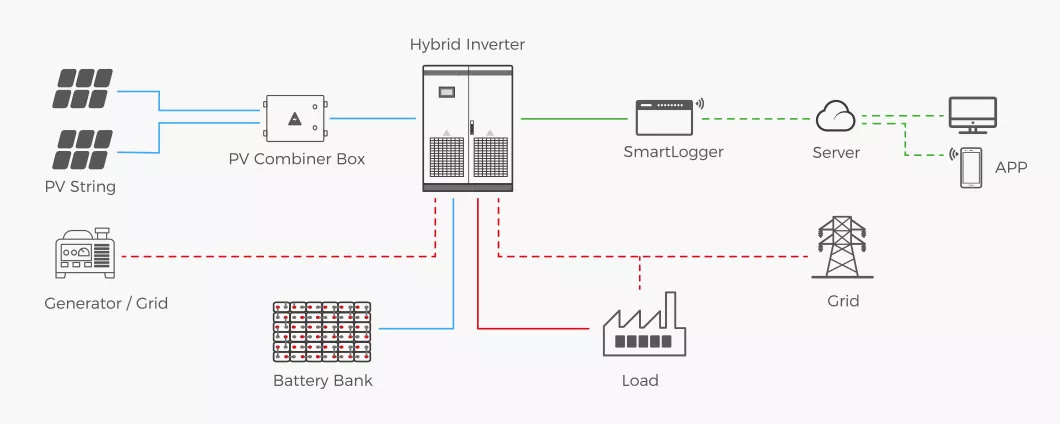Hybrid Solar Systems Are Becoming A New Choice for More and More People
Release Time:
22 May,2025

The hybrid solar system is an intelligent energy solution that combines solar photovoltaic (PV) generation, energy storage (e.g., batteries), and grid power (or backup generators). It enables self-consumption of solar energy, stores excess electricity, and draws power from the grid or storage when needed, improving energy efficiency and cost-effectiveness.
Components of a Hybrid Solar System
A hybrid solar system typically includes the following core components:
Solar PV Panels: Convert sunlight into electricity.
Hybrid Inverter:
Manages solar generation, battery charging/discharging, and grid interaction.
Supports both grid-tied and off-grid operation modes.
Battery Storage (e.g., lithium-ion, lead-acid):
Stores surplus solar energy for use at night or during cloudy days.
Grid Connection (Optional):
Allows selling excess power to the grid (e.g., under Feed-in Tariff policies) or purchasing power during low-cost periods.
Backup Generator (Optional):
Diesel or gas generator provides emergency power during extended outages.
Energy Management System (EMS):
Intelligently optimizes energy distribution, prioritizing solar, battery, or grid power.
Advantages of Hybrid Solar Systems
(1) Increased Energy Self-Sufficiency
Solar power is used during the day, while excess energy is stored in batteries for nighttime or cloudy conditions, reducing grid dependence.
Ideal for areas with unstable grids or high electricity costs (e.g., Africa, Australia, islands).
(2) Lower Electricity Costs
Peak/Off-Peak Management: Charges batteries during low-cost periods (from solar or grid) and discharges during peak hours to save on bills.
Reduced Grid Reliance: Minimizes grid consumption, avoiding high tariffs or blackout-related losses.
(3) Enhanced Power Reliability
Automatically switches to battery power (UPS function) during grid outages, ensuring uninterrupted supply for critical loads.
Suitable for hospitals, data centers, and factories requiring high reliability.
(4) Environmentally Sustainable
Maximizes renewable energy use, reducing fossil fuel dependence and carbon emissions.
More flexible than off-grid systems, with optimized battery sizing to minimize waste.
(5) Smart Energy Management
Remote monitoring via mobile apps or cloud platforms for optimized charging/discharging.
Future integration with Virtual Power Plants (VPPs) to participate in grid services (e.g., peak shaving) for additional revenue.
Applications of Hybrid Solar Systems
Residential:
Lowers electricity bills, enhances energy independence, and provides backup power.
Commercial & Industrial:
Reduces costs via time-of-use arbitrage and ensures stable operations.
Off-Grid/Remote Areas:
Powers islands, mountainous regions, and mining sites with unreliable or no grid access.
Microgrids:
Community or industrial park systems integrating solar + storage + diesel generators.
Future Trends
Solar + Storage + EV Integration
Solar + Storage + Chargers: Supplies green power for electric vehicles (EVs), reducing charging costs.
Vehicle-to-Home/Grid (V2H/V2G): Uses EV batteries as backup power for homes or the grid.
Policy & Business Model Innovations
Shared Energy Storage: Community or enterprise-based storage sharing to reduce costs.
Green Financing: Government subsidies and low-interest loans to boost adoption.
Modular & Plug-and-Play Systems
Standardized designs for easier installation and lower costs, enabling rapid residential deployment.
With a hybrid solar system, you will always have power no matter what the situation. With a backup battery, excess energy produced by your solar panels (but not used by your home) will be stored in the battery. The battery will then provide you with power at night, when the sun is out, during system outages, or during severe weather.
Key words:
Previous:






